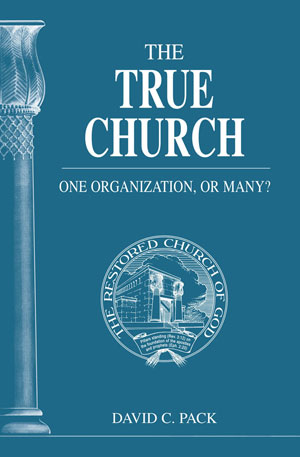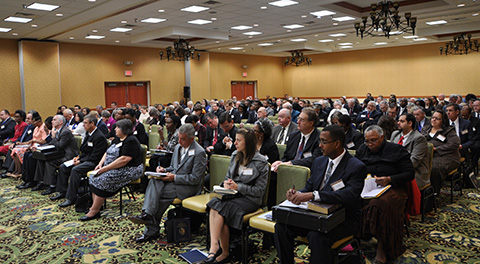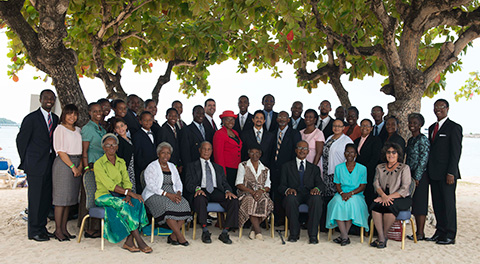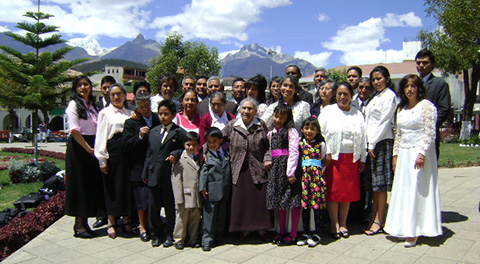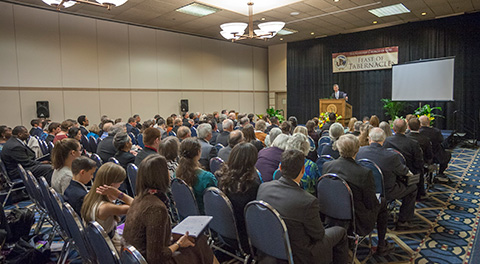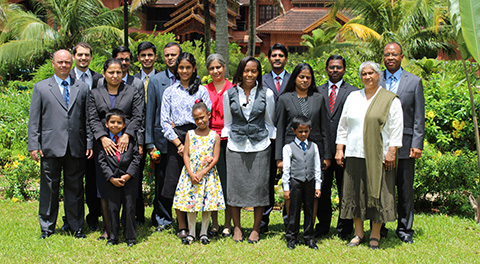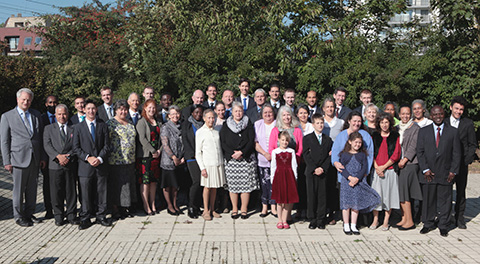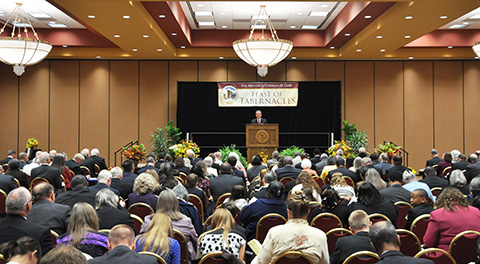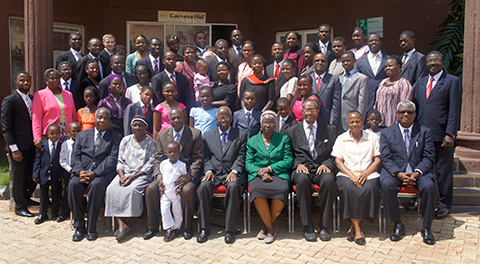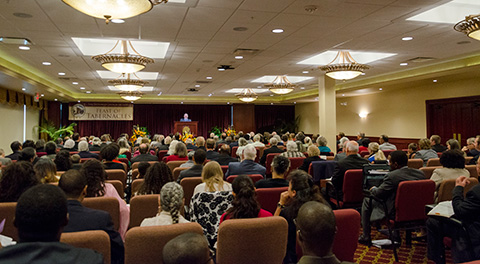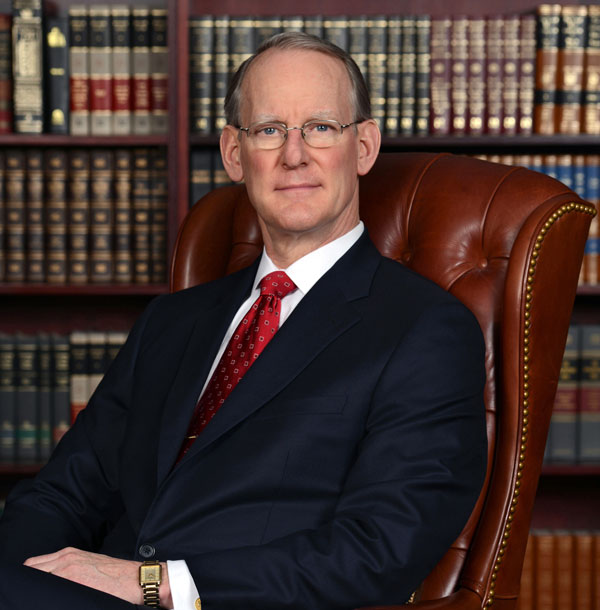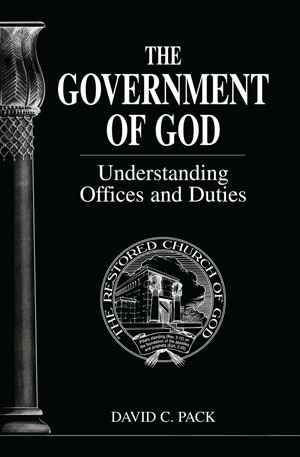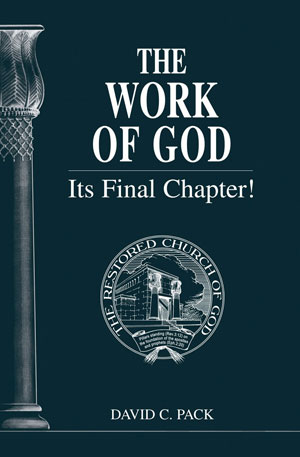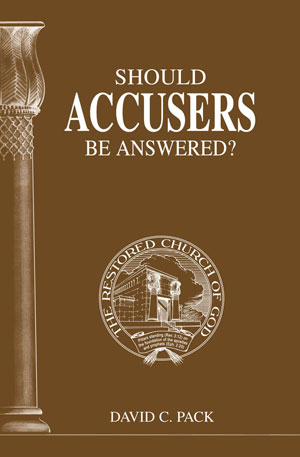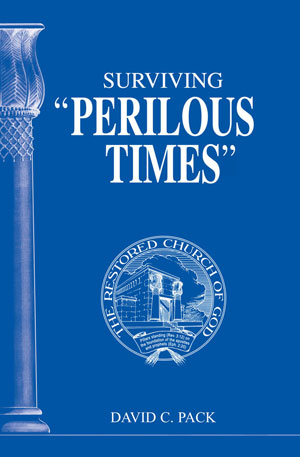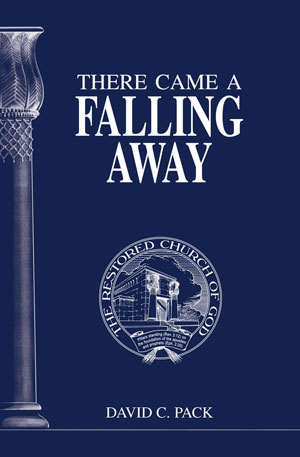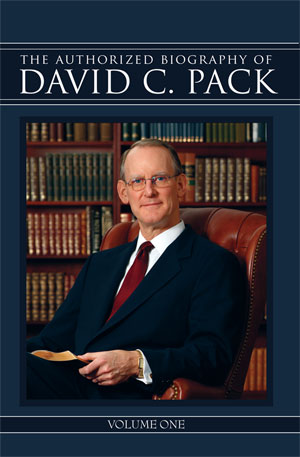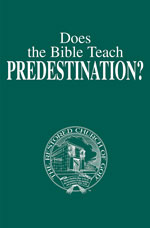We have seen that men have their own differing definitions of what the Church actually is—and these statements could be listed almost without end—but only the Bible definition—God’s definition—matters. Of course, for those who accept the weight of Mr. Armstrong’s words, recognizing that he based every statement on the Bible, we might say the matter has already been settled. The reader either believes Mr. Armstrong was honest and correct with the many scriptures he quoted in just the few quotes we read or he does not. In any event, we must take the time to look much more closely at what the Bible teaches—beyond what a few quotes could demonstrate.
Now comes the most crucial chapter of the book. We will examine many verses—Old Testament and New—proving there could be, and always has been, only one Church. We will start with the clearest passages. All with an open mind will understand from plain Bible passages that Christ’s Church will not—and cannot!—be divided. As you read, determine to equip yourself with this . Take an active approach—think about what you are reading!
There are many verses—!—making absolutely clear that Christ built—constructed—only one unified organization—you will see to be one “House of God” and “Temple of the Lord.” Understand there will be necessary overlap with what we saw Mr. Armstrong taught. But he taught from the Bible. A chapter revealing the same truths would be similar. In fact, the Bible’s very authority is at stake.
Simple Definition
The apostle Paul wrote to Timothy, “…that you may know how you ought to behave yourself in the house of God, which is the church of the living God, the pillar and ground of the truth” (I Tim. 3:15). In the end, no other definition, devised by men, is acceptable. This definition of the Church that Christ built will guide us throughout the remainder of this chapter. The point is that the Church of God has and teaches “the truth.”
This world’s churches are in confusion, divided by endless disagreement over doctrine, practice and personality. Amos 3:3 asks, “Can two walk together, except they be agreed?” Of course not! One split after another in the splinters just over power and control—where the correction of false doctrines is often not even in the discussion—proves this.
This world’s churches do not practice “Man shall not live by bread alone, but by every word of God” (Luke 4:4). Instead, since they follow the differing traditions of men, endless disagreements divide and produce more and more churches of men. These organizations do not “walk together,” because they do not “agree”—with each other or with God! (We have seen this includes the definition of what is the New Testament Church.)
God’s Church is different. Many New Testament passages show that the Church Christ built is unified—with all its members and congregations walking together in with each other, and with God and Christ.
Extraordinary Oneness
An important point, demonstrating the unity to be seen in the true Church, emerges from Christ’s prayer, on the night of His betrayal: “For their sakes I sanctify Myself, that they also might be sanctified [set apart] through the truth…That they all may be ; as You, Father, are in Me, and I in You, that they also may be in Us: that the world may believe that You have sent Me. And the glory which You gave Me I have given them; that they may be one, even as We are : I in them, and You in Me, that they may be made perfect in ; and that the world may know that You have sent Me, and have loved them, as You have loved Me” (John 17:19, 21-23).
This forms a series of powerful statements! Christ intended His Church be “one” no less than were He and His Father! There is no room for disagreement in a Church this unified. These verses describe a perfect oneness through the truth—the same kind of oneness the Father and Christ enjoy. It is this kind of unity that allows true Christians to be “in” them—in Christ and in the Father (vs. 21).
God wanted even the Old Testament Church in the wilderness to reflect the same oneness that Christ prayed about regarding the New Testament Church. King David recorded, “Behold, how good and how pleasant it is for brethren to dwell together in unity” (Psa. 133:1). Ancient Israel never achieved this, but it was God’s intent from the beginning.
In his letter to the Corinthians, Paul wrote that the Church has many members (individual brethren), and that this is likened to various parts of the human body, in that these members are connected. But you will see that this is really a picture of Christ’s Body, not merely a human body.
A careful study of I Corinthians 12 brings extraordinary understanding. Verses 12 to 14 state, “For as the body is , and has many members, and all the members of that body, being many, are body: so also is Christ. For by Spirit are we all baptized into body…For the body is not one member, but many.”
So then, exactly what is the “one” Church or Body into which a person has been baptized? When Jesus walked the earth, His preaching of the gospel and other teachings, and all miracles and works He did, were done through and from His physical body. Of course, after crucifixion and burial, Christ’s Body was later resurrected as Spirit, before ascending to heaven, requiring that His work and preaching be transferred to another entity, His Church—which Scripture makes plain that Jesus Christ still considers to be His “Body” continuing on Earth what He started.
A brief portion of a quote from Mr. Armstrong returns to clarify this:
“God started His Gospel WORK—proclaiming the Gospel (good news) of —through the individual human of Jesus. But after His resurrection, Jesus sent the same on the day of Pentecost, A.D. 31, and thereafter, to enter into the of those constituting .
“The , then, is the Christ uses as , empowered by God’s Spirit, to carry on . Jesus Christ heads and directs it from heaven!”
The context of I Corinthians 12 uses the analogy of hands, feet, eyes, ears and the mouth to show how different parts of a human body (Christ’s body was once human) are connected within the same person. Paul continues, “But now has God set the members every one of them in the body, as it has pleased Him. And if they were all one member, where were the body? But now are they many members, yet but one body” (vs. 18-20).
Let’s further understand what this means. You saw the “Christian” world teaches that Jesus’ Church consists of many denominations, fellowships or communities of believers, all connected by the Holy Spirit working in believers wherever they are affiliated. But you are already seeing reasons proving this is totally contrary to what the Bible teaches. Here is more about why.
I Corinthians 12 cannot be “spiritualized away” by human reasoning. This chapter cannot be describing the kind of amorphous, disconnected, “spiritual” body of disagreeing people and organizations throughout professing Christianity. Any foot, eye or ear taken from a human body dies! No severed human body part can live long without blood supply and the connective tissue necessary to secure it to the body. God created the human body—He understands the analogy that He inspired. Everyone knows that a dismembered human body is one in pieces. How can brethren (splinter members) believe that Christ’s Body can be dis“member”ed yet somehow still be together?
The physical-spiritual parallel is unmistakable.
All body parts respond to the head. They cannot be dysfunctional or spastic. The entire nervous system, led by the brain, must be in working order, operating with coordination. A human being cannot live without his or her body, with all of its parts, connected to and governed by the head! There is only one member that cannot be reattached if cut off—the head! (Notice that Paul listed the head as a member.) All bodies without heads die. If the spiritual Head (Christ) is severed from His Body, the Church will die! The splinters are works of men. Being outwardly attractive (to the superficial viewer) does not make Christ their Head. Having cut Christ—the Head—off, they are governments and churches of men, teaching many doctrines of men. You are learning about one of the biggest.
Why have so many seemingly forgotten the entirety of (and simplicity within) I Corinthians 12, which is basically a 31-verse explanation comparing the physical human body—and all of its connected parts (eyes, ears, mouth, hands, feet, etc.)—to the spiritual Body of Christ? It is because plain meaning has been “spiritualized away” by most brethren. The obvious meaning intended is that any part of the body (the physical human body or Christ’s spiritual Body) will die if severed away—no longer connected in its God-designed place.
The End of the Matter
All speculation about God’s intended meaning in I Corinthians 12 abruptly ends in the middle of verse 24. Notice: “God has tempered the body together, having given more abundant honor to that part which lacked: that there should be no schism in the body” (vs. 24-25). Think. The Greek word that is translated schism could also be translated “division,” “split” or “gap.” Also, tempered together means “co-mingle,” “combine” and “mix with.” The honest Bible student finds not an inch of room in this passage for multiple organizations and groups—or even two organizations.
Mr. Armstrong got it right.
The Church once understood that it was the Protestants who “spiritualize away” plain scriptures regarding God’s Law, Sabbath, Holy Days, tithing, unclean meats, etc. Why do thousands of God’s people now do the same thing—or permit their leaders to do it? How could they miss the lesson of what the apostates did time and again—causing such disruption in their lives? How could they so quickly forget how scores of thousands of brethren suffered and how the Work of God was temporarily destroyed because of such dishonesty with God’s Word? If this describes you, will you admit it?
Consider again two scriptures that opened Chapter One: “He [Christ] is the head of the body, the Church” (Col. 1:18), and “[God] gave Him [Christ] to be the Head over all things to the Church, which is His Body” (Eph. 1:22-23). The Body of Christ is the Church, and vice versa! Therefore, I Corinthians 12 qualifies both terms. The manifest integration of the human body makes clear that all parts work together in God’s Church!
Ponder this. Those claiming that Christ’s Body is scattered in different groups imply Christ lacks the power—is too impotent—to keep His efforts united. Conversely, this suggests that men and/or the devil can block or destroy the unity that Christ intends—and that He is powerless to do anything about it!
“The Gates of the Grave”
Let’s review Matthew 16:18 one more time. Some overlap from earlier is necessary while we draw certain conclusions. Jesus promised His disciples that, “The gates of hell [the grave] shall not prevail against [the Church].” I first heard of that promise 45 years ago. I believed it then—and still do!
Be honest! If the devil could enter and destroy the Church’s government (the government of God)—I am not speaking of corporate governance—the only means and structure of authority and power by which Christ guides His Body and Work—he has destroyed the Church! Admit this to yourself. All that Satan really must do is convince God’s people, through a series of clever, seductive arguments from his agents, that God’s government as they knew it is no more. When this is accomplished, he has effectively removed the ability of God’s people to remain together, to practice teamwork and to continue the Work of God in larger form together.
This would mean the devil holds power sufficient to defeat the purpose of the Church!—to defeat what is seen to be one of the very greatest promises in all of the Bible!
Do you believe that possible? If so, then you believe the gates of hell can prevail against the Church. You also believe that when Christ said to the apostles that He would be “with [them] always, even unto the end of the world” (Matt. 28:20), He had some other meaning in mind than what the Church always thought was the obvious one. This was said in the context of Christ’s own authority, and how power and authority were to be given to the apostles. He explained to them that the Father had given Him all power, and that He would give it to them in order that they could baptize and teach all things to all nations. Is the devil’s power greater than the power of God?
I ask again: Do you believe that the living Jesus Christ—the same Person who made 30 billion trillion stars (the new estimate recently announced)!—can be pushed from leadership over His Church and Body by men, or by the devil? In fact, prophecy reveals that it is Satan who will soon be removed from his throne, with this to occur at the same time all rule, power and authority of men is put down by Christ and the saints.
Why do—how could—so many forget the power and authority—and certainty!—of Christ and His government?
Hypothetical Thinking
It is time for humor. Think of Christ, in heaven, as another organization splits away from any particular “true Church.” Imagine His position: “Oh no, men have started another true Church! I am now the Head of another organization not of My choosing. My Work has been further diffused. My people have been further divided. Oh well, let’s see what My new ‘true Church’ teaches. And let’s see what is the structure of government that has been chosen on My behalf. I also need to know what doctrines are being taught in My name to see what I have become the Head of.” This is the position in which blind, foolish men seem willing to put their “Jesus.” The body of “another Jesus,” who is one with another god (II Cor. 4:4), would of course happily do this as often as possible. This is commonly called Christendom.
Does the true Jesus Christ follow or lead?
Do you see the UTTERLY LUDICROUS position of rebellious, fighting, competing ministers—and that they think the , permits them to do this with impunity? If Elijah could mock the prophets of Baal (I Kings 18:27), I can certainly mock the thinking of such leading the splinters. How do they dare so trample the truth of the Jesus Christ they profess to serve? How do they live with themselves? How do they sleep at night? How can they handle the Word of God SO DISHONESTLY? And where do they find the gall to ask God’s people to buy into their thinking?
Worse, how do so many brethren let them get away with it?
Perfect Unity
In chapter 4 of Ephesians, Paul went on to admonish the brethren there to be “Endeavoring to keep the unity of the Spirit in the bond of peace. There is [Church], and Spirit, even as you are called in hope of your calling; Lord, faith, baptism, God and Father” (3-6).
There is no confusing the all-encompassing unity and agreement this verse requires of God’s people. It mirrors Christ’s John 17 prayer for the absolute oneness that He and the Father enjoy. We might ask: If the Father and Christ were on Earth, would they attend two different churches, teaching different things—but paper over it by declaring that they were connected amorphously “through the Holy Spirit” in some kind of incomprehensible “oneness”?
Such silly questions and faulty reasoning can be helpful in seeing the false logic that YOUR LEADERS bring to even the . But there is more.
A few verses later, Paul described the crucial role of a faithful ministry, actively working with and teaching Christ’s Church. Comprehend this lengthy passage:
“He gave some, apostles; and some, prophets; and some, evangelists; and some, pastors and teachers; for the perfecting of the saints, for the work of the ministry, for the edifying of the body of Christ: till we all come in the unity of the faith, and of the knowledge of the Son of God, unto a perfect man, unto the measure of the stature of the fullness of Christ: that we henceforth be no more children, tossed to and fro, and carried about with every wind of doctrine, by the sleight of men, and cunning craftiness, whereby they lie in wait to DECEIVE; but speaking the in love, may grow up into Him in all things, which is the Head, even Christ: from whom the fitly joined together and compacted by that which every joint supplies, according to the effectual working in the measure of every part, makes increase of the body unto the edifying of itself in love” (Eph. 4:11-16).
This block of Scripture pictures the Body as unified in both doctrinal truth and love. Phrase after phrase demonstrates that the entire Church (“whole body” and “every part”) must be walking together in complete agreement under Christ’s authority. Notice that He uses His ministers—true ministers!—to keep His Church from drifting into “every wind of doctrine.” I am seeking to do this now for those who care.
If you do not accept what Jesus Christ, as Head of the Church, inspired Paul to record, you are effectively “putting words” in Christ’s mouth. You have Him saying, “You must throw out all the analogies I use to assist in understanding what I am talking about. None of them actually mean what they appear to say. They are just the best I can think of. ‘Body’ doesn’t mean ‘Body,’ nor do My terms ‘knit together,’ ‘framed together,’ ‘tempered together,’ ‘compacted,’ ‘no schisms’ and ‘no divisions’ mean what you might say is obvious. I have something entirely different in mind from what I appear to mean in every case—I just don’t know how best to say it.”
Jesus Christ is the “Logos”—the Father’s Spokesman for all matters within His Plan. Think of what your leaders have done with Jesus Christ’s plain teaching. They have effectively reduced the Being who made the sun, moon and stars into an utterly incompetent communicator on even the most vitally important subjects—those that must not be misunderstood!
Do you believe them?
Temple of the Lord
The subject of Christ’s Body is incomplete until another vital connection is made. The New Testament Church and Body are also called the “Temple of the Lord.” A number of passages make this plain—and you must understand their meaning.
The magnificent Old Testament Temple (built by Solomon, later rebuilt by Zerubbabel, and afterwards renovated by Herod) was where God dwelled. All Israel knew this. This Temple was often referred to as the “House of the Lord.” You will see that the New Testament uses the same terms.
The term “temple” is found in a host of contexts throughout the New Testament. This word appears literally scores of times through the gospels and epistles of Paul, as well as in various places in the book of Revelation, usually there referring to the Temple around God’s throne in the third heaven.
Briefly, the English word translated “temple” generally derives from three separate Greek words that can correctly be translated as “temple.” These are oikos (oy’ kos): “a dwelling, by implication a family home, household or temple”—hieron (hee-er-on’): “a sacred place, that is, the entire precincts of the temple (at Jerusalem or elsewhere)”—and naos (nah-os’): “a feign shrined temple—the central sanctuary itself.”
An examination of where these different words are used is its own interesting study. However, certain straightforward passages make very plain what—more correctly, who—is the Temple of God today.
Fundamental Passages
John 2:19-21 is the place to start. It offers important proof that the Body of Christ is the same as the Temple of God. As you read, realize Jesus’ words are the Bible interpreting the Bible, and they provide the best introduction to the New Testament Temple. Note especially the final part of the passage: “Jesus answered and said unto them, Destroy this temple, and in three days I will raise it up. Then said the Jews, Forty and six years was this temple in building [they thought He meant the renovated second temple built after Solomon’s had been destroyed], and will You rear it up in three days? But He spoke of the temple of His body.”
If you understand that Christ’s “Body” is also His “Temple”—and that the “Temple” is “His Body”—obviously the same as the “Body of Christ”—you cannot get confused. All you must do is take Jesus’ words at face value. The Bible will continue interpreting itself.
Paul recorded much more than any other Bible writer about the New Testament Temple. First is his foundational statement in Ephesians: “Now therefore ye are no more strangers and foreigners, but fellowcitizens with the saints, and of the household of God; and are built upon the foundation of the apostles and prophets, Jesus Christ Himself being the chief corner stone; in whom all the fitly framed together grows unto an holy ” (2:19-21).
He added this to the Corinthians: “For we are laborers together with God: ye are God’s husbandry, ye are God’s ” (I Cor. 3:9).
Note this. Unlike the custom of today’s English, the King James translators carefully used “ye” whenever the intent was plural and “you” when it was singular. The ye in each case references all of the Ephesians and all of the Corinthians—and thus means the whole Church, collectively. It will become clearer as we proceed that individual members are not the Temple of God, but rather the entire Church as a whole constitutes it. Of course, this is not new.
We will later come to understand how the Bible describes—the specific term that it uses for—individuals within that Temple. The supreme importance of serving God in the manner and in the place that He requires cannot be overstressed.
A few verses later in I Corinthians 3, Paul added this: “Know ye not that ye are the , and that the Spirit of God dwells in ye? If any man defile the , him shall God destroy; for the is holy, which ye are” (vs. 16-17).
Together, these verses reveal that God sees His people—the true Church—as both His Building and His Temple. Understand that God is building a Temple—or a “House” (seen momentarily). Almost identical, I Corinthians 6:19 does add a little more, these verses together making clear how serious it is if those called of God treat lightly the awesome privilege of having God dwell in them.
The second epistle to Corinth adds significantly more understanding. Let’s notice: “What agreement has the with idols? For ye [the plural is used throughout] are the [incidentally, in light of LCG’s name, note the emphasis again this time on the “living God” not the living “temple”].” Paul continues, “…as God has said, I will dwell in them, and walk in them; and I will be their God, and they shall be My people” (6:16).
The last part of this passage comes from Leviticus 26:12. Its use here demonstrates God has always planned—“has said” from the beginning—that His Church, those in whom He would in the future personally dwell, would be the greatest Temple of all. Recognize that Leviticus was recorded long before either Solomon’s or Zerubbabel’s Temple was built.
There is a powerful message for everyone in the verses leading up to II Corinthians 6:16, quoted above. For those desiring to be in God’s Temple, there exists no room—none!—for doctrinal compromise with the false, pagan teachings of counterfeit Christianity—summarized as “unrighteousness” and “darkness” in verse 14. Christians are to “touch not the unclean thing” (vs. 17)—anything that is sin. This would certainly include the false, Protestant “Body of Christ” doctrine, and even more so since this teaching also perverts what the New Testament Temple is.
Pause to read verses 14 and 15. Then take time to read each phrase in Ephesians 5:6-11, followed by verses 23 and 30. The first group of verses condemn all compromise with every form of unrighteousness. The latter tie Christ as Head of “the Church” to those in it being what He calls—read carefully!—“members of His Body, of His flesh, and of His bones.”
Let this understanding of exactly what it means to be in the Body of Christ !
“HOUSE of God”
A final proof (there are several others) that the Church of God, the biblical Body of Christ and the Temple or House of God are the exact same thing is understood by comparing three more passages in Paul’s epistles. Follow what they connect. Do not miss what God reveals!
We begin by revisiting I Timothy 3:15. This crucial but largely ignored bedrock passage provides the New Testament definition of the true Church of God. Notice the Church is there called “the house of God…the Church of the living God, the pillar and ground of the .” (Take more than a passing interest that this verse ties the Church to where “the truth” is—not “some of the truth” or “much of the truth” or even “most of the truth”—and certainly not “truth mixed with error”—but rather simply “THE TRUTH”!) Now pause and read John 4:23-24!
Then, get clear in your mind that the Church is called “the of God.” (It is more than interesting that this is the same term used from the beginning regarding Solomon’s Temple, generally in the Old Testament referred to as the “House of the Lord,” or “God’s House,” as in I Kings 6:37-38.)
Recall Jesus taught in Matthew that “a divided…cannot stand” (12:25). Why do those who teach the New Testament Church is scattered among many organizations never reference this verse? Christ went on to explain that even the devil realizes his “kingdom” cannot survive divided.
Surely Christ is at least as wise as the devil. He would not have a lower standard of unity than THE DEVIL! The splinters, however, are divided due to many doctrinal errors. But where Christ is working, it is not divided by different beliefs (I Cor. 1:10-11). Grasp this! (More later on Matthew 12:25.)
Recall that Paul called the Temple of the Lord a “ fitly framed together” (Eph. 2:19-21). Here is the point not to be missed. Two chapters later he said the identical thing about the Body of Christ. Notice: “From whom the fitly joined together and compacted [we saw I Corinthians 12:24 adds “tempered…together”] by that which every joint supplies, according to the effectual working in the measure of every part…” (Eph. 4:16).
The Greek—Fascinating Meaning
The phrases “fitly framed together” and “fitly joined together” are translated from the same Greek word sunarmologeo. It means “to render close-jointed together, i.e. organized compactly, be fitly framed (joined) together (in the sense of laying).” Paul obviously had the same thing in mind whether discussing the Church, the Temple (or House of God) or the Body of Christ.
Sunarmologeo offers truly fascinating meaning. The beginning and last portions of the definition—“render close-jointed” and “together (in the sense of laying)”—carry the obvious meaning of laying individual stones that are mortared or put “close-jointed” beside each other (“together”) as one would lay them in rows within a building.
Since we saw that the Temple of the Lord is also called God’s “building,” there is no possible way to read these passages and conclude that the true Church could be anything other than one undivided organization—a ! Do not let anyone tell you that God’s Temple is less than this! Christ’s Building cannot be “spiritualized away” any more than can His Body.
“Living Stones”
Now let’s look more closely at what are the “stones” used in building—exactly what or who it is that lies together “close-jointed.” At this point the knowledge presented becomes personal. The apostle Peter put an exclamation point—a capstone!—on all that Paul wrote about the New Testament Temple.
God declares this to true Christians through the ages: “If so be ye [plural again] have tasted that the Lord is gracious. To Whom coming, as unto a [Christ], disallowed indeed of men, but chosen of God, and precious, ye also, as [living] , are built up a , an holy priesthood, to offer up spiritual sacrifices, acceptable to God by Jesus Christ. Wherefore also it is contained in the scripture, Behold, I lay in Zion a chief corner stone, elect, precious: and he that believes on Him shall not be confounded” (I Pet. 2:3-6).
It becomes easy to understand now that the living stones (Christ being the Chief Corner Stone) are individual Christians in the Temple lying “close-jointed”—“fitly framed TOGETHER.” Think of how wonderfully close the stones in Solomon’s Temple were, and the message in their settings. And note that it was only the priests who could enter and serve in the Temple (II Chron. 23:6). Finally, note that I Peter 2:5 should carry the stronger rendering of the “be ye [BE YE!] also living stones,” as in many Bible margins.
This is incredible understanding, for those able to receive it. Does the description of living stones closely framed together sound like people attending a host of different churches with different beliefs? In contrast to Peter and Paul’s description, do not the splinters look more like pictures of buildings reduced to rubble—piles of bricks—in German cities after WWII Allied bombers had finished with them?
Dead Stones
Peter wrote more, and our understanding cannot be complete without it: “Unto you therefore which believe He is precious: but unto them which be disobedient, the Stone which the builders disallowed [or “rejected”], the same is made the head of the corner, and a stone of stumbling, and a rock of offense, even to them which stumble at the word, being disobedient: whereunto also they were appointed. But ye [the Church] are a chosen generation, a royal priesthood, an holy nation, a peculiar people; that ye should show forth the praises of Him who has called you out of darkness into His marvelous light” (vs. 7-9).
The world has never been willing to accept the true Jesus Christ! Neither will they accept the Church He built—and is still building. They “stumble” at His doctrines, and reject—“disallow”—Him as the Head of the Church—meaning the churches they build. In His place they bring a cold, dead Jesus (“another Jesus”) on a cross, who brings dead understanding (empty pagan doctrines), and who builds dead churches out of dead stones!
Most will not hold precious the true Jesus Christ of the Bible. Neither will they hold to His teachings (of course, most will not even study them). They will not yield to His government. Neither will they come to His Church, nor support the Work of that Church. And they will not permit Him to head their lives—and build them into His House. Blind to their actions, they keep themselves outside the Temple He is constructing. All mankind has unwittingly chosen not to be placed next to the “living stones” with which God builds. (My thorough book The True Jesus Christ – Unknown to Christianity is worth your reading. It will change you forever.)
God’s “House” is the same as His “Temple”—of which you were called to be a “living stone,” one “closely joined” with all the others in God’s unified “Building.” Why are brethren not willing to accept that God’s Church—the Body of Christ—His House or Temple—is so obviously ruled by Jesus Christ as Head under the government of God—and doing His Work?
Dying Stones—Half Dead, Half Alive
What could be more important to understand than these points? What could be more important than allowing yourself to be placed by Christ into the Temple—into the very “House of God”? What could be more important to you than recapturing the basic, but all-important, knowledge that, “Except the build the , they labor in vain that build it” (Psa. 127:1)? There is but one House God could have had in mind in this passage—the one He planned long before the Psalms were recorded. (Recall Leviticus 26:12.)
Regarding the churches of men—the splinters—how could their founders think they could build their own “houses” and that Christ would submit to their lead, and follow them, instead of the other way around?
And how could so many thousands blindly help them build?
The majority today have made themselves “branches cut off” from the true Christ—not YET dead in most cases, but rather having made themselves DYING stones, stones with the “oil” of God’s Spirit flowing out of their “lamps” (Matt. 25:1-12). “Branches” cut from the “Vine”—stones taken from the Builder—God’s Spirit is not being replenished in them! How long before it is gone—and gone from you?
Tragically, most simply no longer seem able to even remember that Philadelphians are promised to be “pillar[s] in the [coming] Temple of…God” (Rev. 3:12).
How did all this incredible knowledge get lost to thousands?
One Nation
There is a reason Peter called God’s Church “a chosen generation, a royal priesthood, an holy nation, a peculiar people.” The four phrases in this verse are in the singular—meaning one, not several, of each term referenced. If a nation is split into several nations, no one would consider it to be a (single) nation—it would be multiple nations, not “a” nation. The same is true of God’s Church.
There is but !
Consider further. The Church is referred to as (spiritual) Israel. In the Old Testament, Israel was a nation. Did anyone doubt that ancient Israel was one nation, with one civil authority and one set of laws and teachings? One could not move to Syria and still be in the nation of Israel. One could not live in Egypt and be in Israel. You have to live in Israel to be in Israel. All understand what “a” nation means. Israel consisted of twelve tribes, but they were all under one government, one judge, one high priest, one king, etc.
Also notice Exodus 19:5-6. It demonstrates God’s intention from the beginning: “If you [Israel] will obey My voice…and keep My covenant, then you shall be a peculiar treasure unto Me [Peter used “a peculiar people”] above all people: for all the earth is Mine: and you shall be unto Me a kingdom of priests [Peter used “a royal priesthood”].” God knew Israel would rebel so He had to build a spiritual nation—the one true Church. Understand the connection.
Houses Divided
Christ Himself taught about the importance of unity in His House. Let’s expand on a scripture we referenced earlier: “Every kingdom divided against itself is brought to desolation; and every city or divided against itself shall not stand [survive]” (Matt. 12:25). I repeat from earlier, surely the great God of heaven and Jesus Christ are as wise as the devil.
Can a divided marriage continue indefinitely? Could even the most powerful company survive if its board of directors were divided? Could a winning professional football or soccer team survive if the coach continually challenged and opposed decisions, policies and judgments of the team’s corporate leadership, or ownership? Could a school survive if every decision made by the principal was challenged by senior teachers on the faculty, and groups of teachers regularly broke away from the school to form more (unauthorized) schools?
Certainly not! Why, then, do God’s people accept the idea that the most important organization on Earth—the Church of God—can be divided into endless squabbling groups? How long could God’s people survive in a state that married couples, companies, sports teams or schools could not endure—and would not be foolish enough to think they could? We are again left to accept that “The children of this world are in their generation wiser than the children of light” (Luke 16:8).
Jesus tells you, “Abide in Me…as the branch cannot bear fruit of itself, except it abide in the vine; no more can you, except you abide in Me…without Me you can do nothing” (John 15:4-5).
Do not miss what is at stake regarding which church you are part of.
Let’s examine just a few verses to see why Mr. Armstrong taught that God only works in one House—one organization. You will see that he was honest with God’s Word. His previous statements reference some of these passages.
Acts 2 records Jesus fulfilling His promise to build His Church. This account of its birth offers extraordinary insight into what it was to look like for the next 2,000 years.
Verse 1 records that “they were all with one accord in .” The first thing that happened after 3,000 were baptized: “They continued steadfastly in the apostles’ doctrine and fellowship, and in breaking of bread, and in prayers” (vs. 42).
Two points emerge. People held to—“continued in”—the “APOSTLES’ doctrine,” not anybody else’s. This statement is enormous—and one of the greatest reasons Mr. Armstrong understood that truth only comes into the Church through apostles. (Also remember Ephesians 2:20.) This doctrine includes understanding what is the Church!
Another monumental point is introduced here—the people also “continued…in…fellowship” together. Verse 44 states, “And all that believed were together…” The Church was together! This is the only way the rest of the verse could state that they “had all things common.” Try applying this to multiple organizations.
Verse 46 ties the knot: “And they, continuing daily with one accord in the temple, and breaking bread from house to house, did eat their meat with gladness and singleness of heart.” All were eating together in “one accord” and “singleness of heart.” This would produce the “gladness” spoken of here. Recall: “How good and how pleasant it is for brethren to dwell together in unity” (Psa. 133:1)! Satan knows this, and has convinced God’s people they can be divided and still be the true Church—and that Christ leads them as and where they are.
We have just reviewed the first snapshot of Christ’s Church. Is the picture coming even clearer—from the Old Testament and the New—and that the devil would necessarily paint a different picture for you?
Unbreakable Standard of Unity
Much can be learned by examining Paul’s instructions to various other congregations he was overseeing. He continually stressed unity and oneness within the true Church.
The Corinthian congregation had many problems—including terrible division and disunity, some of it doctrinal and some because people were selecting “favorite ministers” and speakers. After just nine introductory verses, Paul cuts to the difficulty—and reveals the only way God’s Church is to function: “I beseech you, brethren…that you all speak the same thing, and that there be no divisions among you; but that you be perfectly joined together in the same mind and in the same judgment” (I Cor. 1:10).
In just this one verse, Paul was inspired to describe, in different ways, how all of God’s people in every age should be completely unified and in agreement. This verse, with its obvious meaning, is another that cannot be “spiritualized away” by deceptive human reasoning. No honest mind can possibly draw any other conclusion from this passage. Do not miss the intent. Carefully reread the phrases in italics.
Where in this passage does Christ give license for multiple organizations—“churches”—to appear in His name? Where in this description is there room for hundreds of divided, competing groups, in disagreement over teachings and judgments—and diminished in the all-important impact of taking the gospel announcement of the kingdom of God to the world (Matt. 24:14; 28:19-20)?
Nowhere!
It was in this same letter that Paul had to write, “God is not the author of confusion, but of peace, as in all churches of the saints” (I Cor. 14:33), followed by, “Let all things be done decently and in order” (vs. 40). I ask again, “Why?” Why have people forgotten such basic scriptures? Any definition of “decency” and “order” would be impossible if God’s Church were divided into even a few competing organizations, let alone hundreds.
Verse 13 of I Corinthians 1 begins with the rhetorical question: “Is Christ divided?” The only reason it is not followed with the word “no” or something similar is because the answer is so obvious. Considering what he had just written, Paul knew the thrust of his question was like asking, “Is grass green?” or “Is the sky blue?” Rhetorical questions require no response because everyone knows the answer. “Can two walk together except they be agreed?” is left unanswered for the same reason.
Why can so many brethren no longer grasp such easy questions as “Is Christ divided?” Deep blindness—in the most basic points of spiritual understanding—has settled over the majority of Spirit-begotten people today. They must anoint their eyes as Christ commanded, or they will never see again.
We must ask: What is the cause of this constant splitting and dividing taking place today?
“Not holding the Head”
The Corinthians were not the only congregation that had problems with how Christ leads the Church. So did the Colossians. This congregation had gone off track and back into other old doctrines and ideas, including “vain deceit,” “philosophy,” the “tradition of men” and the “rudiments of the world” (2:8, 20).
Why? What caused most of a congregation to go so far off?
Paul identified the problem—then and today. He told the Colossians they were “not holding the Head” (2:19), which is Jesus Christ and His leadership over the undivided “Body of Christ” (vs. 17). They were looking outside His government and Body, where He was “Head”—in the Colossians’ case to angels for instruction and leadership. Incidentally, if just this much of Colossians were understood—or remembered by God’s people—the so-called “difficult scripture” of chapter 2, verse 16 becomes very easy to understand. Read the whole context of what the Colossians forgot in order to see what practically the entire Worldwide Church of God also forgot.
The reason so many brethren and ministers today have seized for themselves rule of the “Church”—by first creating, and then picking, choosing and moving among many organizations—is because, having forgotten what the Church and government of God look like, they no longer “hold the Head”—the true Jesus Christ.
“Where is the Lord?”
Many today, not just the ministry, have become like those described in Jeremiah 2:8. This verse forms part of the background and setting of verse 31, which describes modernists in Israel who declare, “; we will come no more unto You [God].” Verse 8 had said, “The priests [leaders] said not, Where is the ? And they that handle the law knew Me not: the pastors also transgressed against Me…and walked after things that do not profit.”
While this passage is primarily describing the ministers of this world, it has come to picture the thinking of so many brethren and former WCG ministers today—particularly the ministry, because it is they who “handle the law.” Yet, it also has a very real application to God’s people.
Obvious questions arise: Why are so few in the splinters (starting with leading ministers) willing to ask, “Where is Christ” at work? For instance, when the United Church of God split, did anyone hear a single public statement from even one of the hundreds of ministers (“priests”) there asking, “Where is the [the Head of the Church]?” Why are so many unable to see that raising this question becomes the only way to find His Church and government? Why are thousands not out “moving heaven and earth” to find it? And, most important, why do so few seem to care? The answer lies in the fact that most people now consider THEMSELVES to be “lords”—“We are lords,” Jeremiah wrote. Why would anyone go looking for Christ—to “hold the Head”—when he sees the “lord” in the mirror every day?
Questions for your consideration.
Unity—Goal or Command?
Think about these scriptures in light of just some of the doctrinal points the splinters cannot agree on: whether Mr. Armstrong was an apostle, whether Church eras exist, whether God has a family or is a Family, whether Christians are “born again (from above)” at conversion and not at the Resurrection. How is God’s Church governed? Is Christ’s role part of the gospel of the kingdom of God? Division exists both between and within EVERY splinter.
Paul told the Philippians, “Stand fast in one spirit, with one mind striving together for the faith of the gospel; and in nothing terrified by your adversaries” (1:27-28). And, “Be likeminded, having the same love, being of one accord, of one mind” (2:2). Complete unity is the only condition acceptable to God! Paul’s words appear as a .
Paul told the Colossians to be “knit together in love, and…the full assurance of understanding,” and “rooted and built up in Him, and established in the faith, as you have been taught” (2:2, 7). He describes total unity, walking “together,” assured of right “understanding” they “have been taught” by trained and duly-appointed ministers—starting with an apostle! (We already saw how the Ephesian congregation was similarly admonished.)
So many in the splinters HAVE treated Church unity as merely a goal, not a biblical So many seem to say, “It’s regrettable the churches cannot be united. Unity is a wonderful principle—it is certainly our goal—but it is just not possible today.” How sad what so many people lose out on because of such blind acceptance of their plight.
A Lesson Inside Disfellowshipping
The Roman congregation saw false doctrines creeping in. Paul instructed, “I beseech you, brethren, mark [take note of] them which cause divisions and offenses contrary to the doctrine which you have learned; and avoid them. For they…by good words and fair speeches deceive the hearts of the simple” (16:17-18).
This is strong language. It reintroduces the biblical doctrine of disfellowshipping those who slip into false doctrines, and seek to take others with them—to divide the Church. This principle demonstrates how important it is to God that His people not stray from the truth into “every wind of doctrine.”
Additional scriptures address and amplify this Bible principle. See Titus 3:10-11, I Corinthians 5:1-8 and I Timothy 6:1-5. Together, these passages represent a vital Bible doctrine that the true Church must practice to maintain unity. In addition to ignoring God’s instruction, churches that will not practice this instruction are full of division, discord and disagreement—which inevitably leads to splits within the church or congregation.
Fulfilling the instruction to disfellowship is neither abusive nor an act of hate! It is in fact a form of God’s love administered to people who have drifted into error—and is designed to wake them up. It also protects the remaining brethren. It requires a greater level of faith—that most find too difficult—to obey God’s instruction to protect the Church in this way. Persecution can result. However, obeying God yields the fruits of peace, joy and unity. “Cast out the scorner, and contention shall go out” (Prov. 22:10). It is worth noting that most splinters today only disfellowship ministers who reject error to keep . I know!
These are all real biblical principles—and seen to be , requiring authority to administer—that periodically had to be enforced in the Church in the past. But consider that if the Church is composed of many groups and organizations, with each administering its own distinct and separate authority, carrying out these actions with finality is impossible. So is correcting, admonishing or rebuking, when necessary—either members or ministers.
Here is why. Briefly mentioned earlier, the recipient of the disciplinary action can simply go elsewhere, to any other group or organization—another “true church”—and likely even be welcomed. And again, as is often the case today, he will probably be seen as a virtual “hero” for having seen the light, the “wrong” of the “offending” organization (the other “true church”) that corrected, suspended or disfellowshipped him. In other words, if there are hundreds of “true churches,” it becomes absolutely impossible for the ministry to carry out God’s instruction to discipline those who need it. Those disciplined can always go to another, and then another, and then another “true church.”
But there is a related yet different problem having to do with which are the doctrines that must be defended and which are to be rejected. The ministry—and the brethren—must have a of true teaching to discern who it is they must disfellowship or must avoid. This requires a (recall Mr. Armstrong’s quote) led of Christ to instruct in all true doctrine. Otherwise, each church would have its own standard, creating utter confusion.
The Church as Mother
Let’s go further with the above principle, remembering that one of the greatest responsibilities of the true Church of God is the protection of its members. The plain teaching of the Bible is that the true Church is the spiritual Mother to God’s people. Many important elements of God’s Plan flow from this knowledge. Mr. Armstrong knew and taught that the Church is the “Mother” of the begotten children of God within it. The serious reader will go to Galatians 4:26, Hebrews 12:22-23, all of Revelation 12 and II John 1 and 5 to see this Mother described in various ways. She alone is given the charge—the solemn, God-ordained duty—to keep these children of God secure, safe from harm. How would any human mother accomplish this if her children could freely roam the neighborhood, picking, choosing and living with any other “mother” of choice?
Today, God’s people—His children—are roaming and wandering the streets of a town with 300 “homes” (the number of supposed “true churches” today, with ever more “moving into town”). It could be said that some are with foster mothers, others with adoptive mothers, still others with nannies and babysitters, some at daycare centers, and yet others with kidnappers. In fact, there are now an almost endless array of substitutes, counterfeits and surrogates “welcoming” and “rearing” God’s children.
Every mother knows her own children best, and how they differ from each other. Only the true mother will have a mother’s love for those children. Other “mothers” in the neighborhood are at best pretenders, none of whom will protect or care for her children in the same way she would. Some will quickly cut the child in two when the true mother would save it at all costs. (Ask Solomon about such mothers.) And only the real mother of a child knows best when that child needs correction or discipline. She also knows her other children can be harmed if one child is left out of control. Sometimes that child must “be sent to his room” (isolation).
So it is with protecting the sheep in God’s Church through disciplinary action. The sheep are not permitted to pick and choose among shepherds that would protect them in whatever way they—the sheep!—think best. Nor can they pick another “nicer” mother when their own disciplines them. Yet, this would be the natural byproduct of administering any kind of correction, admonition, suspension, disfellowshipment or even marking when necessary today. In the present circumstances, the member “child” can merely declare, “I don’t like my mommy, I’m going to get another one because she spanked me.” This is translated, “I don’t like the way I was corrected (treated) by my organization, I’m going to find another ‘true church’ that will be willing to accept my conduct and my doctrinal ideas—one that will let me tell my mother how to ‘rear me.’” Worse, the first thing the “new mother” (the next “true church”) usually says is that the child was a victim of abuse, and “did the right thing” by coming to the new, more tolerant and understanding “true church.”
There is a final, critical related aspect of the mother/child analogy to be considered. The Church, like any human mother, is responsible for the diet of her children (in the Church’s case, the spiritual diet). She must work out a daily menu that ensures the health of her growing children. If children do not like the courses their mother serves, they do not have the option of picking a family that serves food to their liking. If a child does not want fruits, vegetables and grains—the typical child!—he cannot go where he will receive only candy and ice cream.
Jesus Christ would never permit His Church to be broken into 300 “homes,” all serving as different “mothers,” in which God’s children can roam, picking and choosing at will. This recognition becomes its own powerful that there has to be one central authority——within the one Church of God administering to the needs—protection, doctrine, discipline and diet—of the Church Christ built! Only the true Mother—the true Church—is authorized by God to do these things!
Understand the many reasons you should not assign to anyone but your true Mother the task of feeding you. Inspired and empowered of God, she is the one most concerned with what you eat.
While we are close to asking if you will “obey the truth,” there are still some questions…



